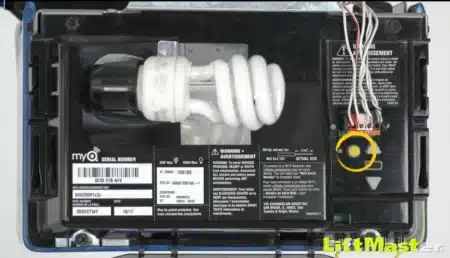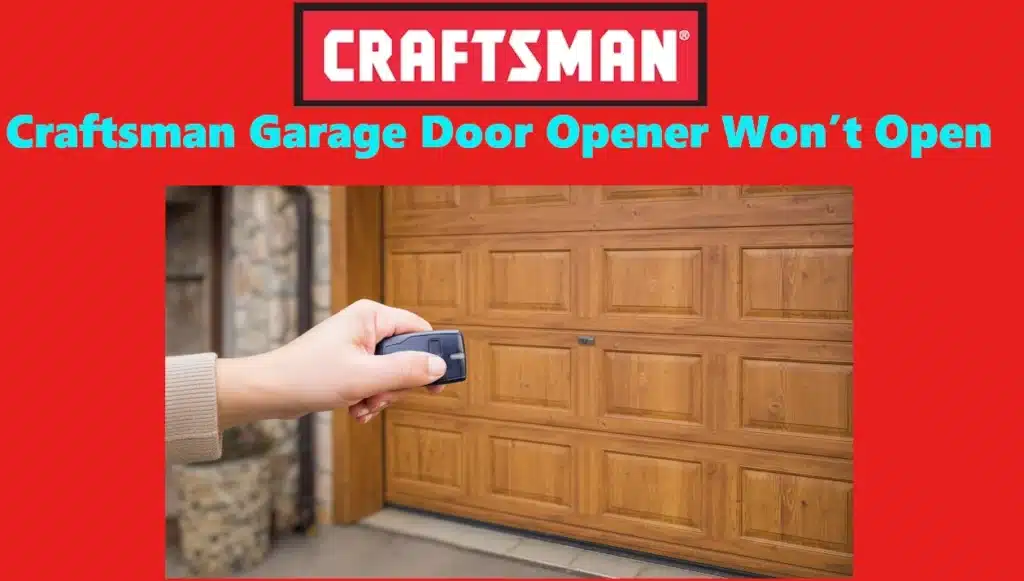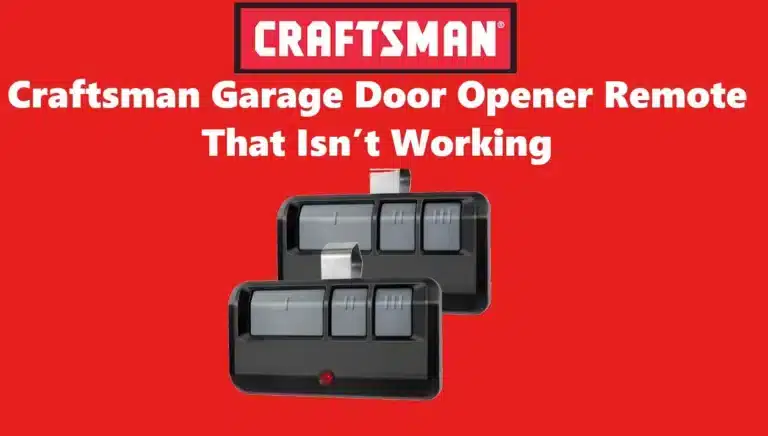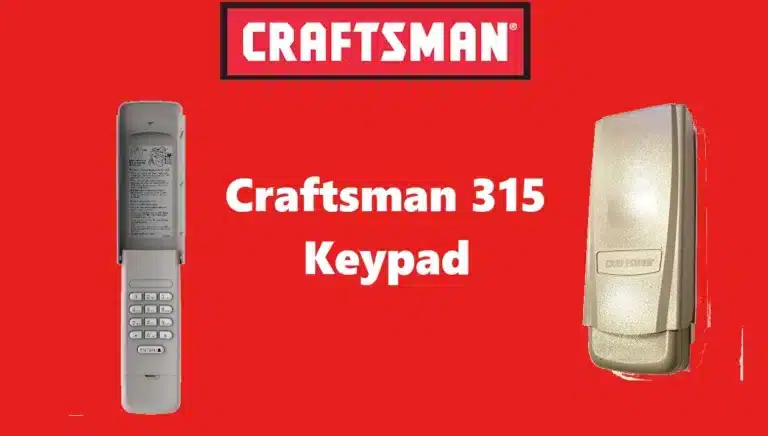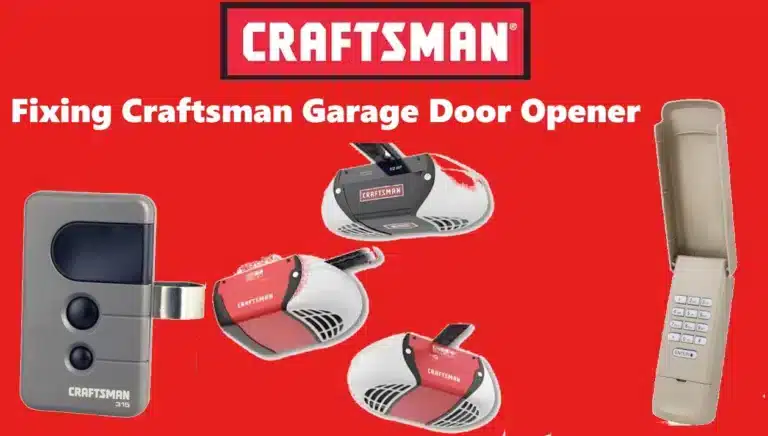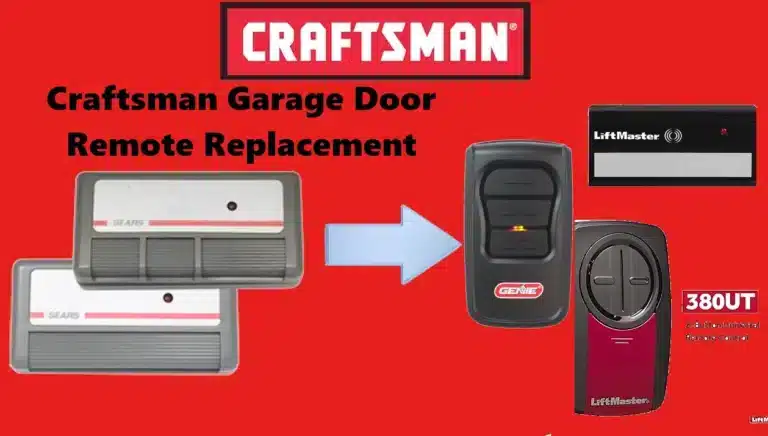It’s a frustrating morning when you hit the button and your Craftsman garage door opener won’t open your door. You might hear the opener’s motor running, but the door itself stays stubbornly closed. Don’t panic – this is a common scenario for homeowners, and there are specific reasons (and fixes) for why a Craftsman opener would run without lifting the door. In this guide, we’ll walk you through troubleshooting steps targeted at Craftsman openers. We’ll cover everything from broken springs to sensor misalignments – all in a casual, homeowner-friendly tone. Read on to learn what to do when your Craftsman garage door opener won’t open, and how to get your garage door moving again.
Why Your Craftsman Garage Door Opener Won’t Open ? (Common Causes)
There are a handful of common issues that can prevent a Craftsman garage door from opening, even if the opener motor seems to be running. Below, we break down each scenario – all specific to Craftsman openers – and explain how to identify and fix the problem. Let’s troubleshoot each cause one by one.
Craftsman Garage Door Opener Won’t Open: Broken Torsion or Extension Springs
One of the most frequent culprits is a broken garage door spring. Your Craftsman opener relies on torsion or extension springs to help lift the heavy door. If a spring snaps, the opener motor might run, but it can’t lift the weight of the door on its own. Most residential garage doors weigh well over 150 pounds, and without the counterbalance of intact springs, even a strong Craftsman opener (typically 1/2 HP or more) will struggle or fail to open the door.
How to tell if springs are broken: You may hear the opener straining or notice the door barely moves an inch before sliding back down. Often, a broken torsion spring makes a loud bang (like a firecracker) when it snaps. You might also see a gap in the torsion spring above the door or a broken extension spring dangling from the ceiling or track. Visually inspect above the garage door – if a spring is in two pieces, it’s broken.
What to do: Do NOT continue to run the opener if you suspect a broken spring. Continuing to use the opener in this state can burn out the motor and cause further damage. Likewise, don’t try to lift the door manually or replace the spring yourself – garage door springs are under extreme tension and can cause serious injury if mishandled. The safest solution is to call a professional garage door technician to replace the broken spring. In the meantime, keep the door closed and refrain from forcing it open. Once the springs are replaced, your Craftsman opener should be able to lift the door smoothly again.
Craftsman Garage Door Opener Won’t Open: Disengaged Trolley or Opener Arm
If you hear your Craftsman opener running but the door isn’t moving at all, the door may have become disconnected from the opener’s trolley (the mechanism that pulls the door along the track). All garage door openers, including Craftsman models, have an emergency release cord – usually a red rope hanging from the trolley. Pulling this cord disengages the opener from the door, allowing you to operate the door manually. When disengaged, the opener will run (you might even see the chain or belt moving), but the door remains in place. In other words, the opener is “unhooked” from the door, so it can’t lift it.
How this happens: Sometimes homeowners pull the emergency release cord intentionally (during a power outage or to do maintenance) and forget to re-engage it. Other times, it can be pulled by accident – perhaps by snagging it with a tall object or if someone tugged it out of curiosity. Additionally, if the door was manually forced or if it was locked and the opener was activated, the trolley could have disconnected to prevent damage.
How to fix it: Reconnecting the door to your Craftsman opener is straightforward. Make sure the garage door is fully closed (or propped securely if it’s stuck partway) before re-engaging. Locate the red release cord: to reconnect, pull the cord down and toward the opener motor. On most Craftsman (Chamberlain-made) openers, this action will cause the trolley to reattach to the opener carriage. You may also hear it snap back into place. Another method: manually slide the door along the track until the attachment point catches the trolley mechanism. Once re-engaged, run the opener again and see if it lifts the door. (Tip: Consult your Craftsman opener’s user manual for specifics on re-engaging the trolley, as designs can vary slightly.)
After reattachment, the door should once again move when the opener runs. If you tugged the cord by mistake, don’t worry – this is a common fix. Just remember that when the opener is disengaged, the motor will run but the door won’t move, so ensuring the trolley is engaged is key.
Craftsman Garage Door Opener Won’t Open: Stripped or Worn Drive Gear or Belt
Does your craftsman opener make a humming noise or grinding sound but the chain or belt isn’t moving? Over time, the internal drive gear in many Craftsman openers can wear out or strip. Craftsman chain-drive and belt-drive openers use a plastic (nylon) gear inside the motor unit to turn the chain/belt that lifts the door. If that gear’s teeth are worn down, the motor will spin but it won’t actually drive the chain – so the door stays closed. This is a common failure in older Craftsman openers (often after years of use or if the door was exceptionally heavy or had a broken spring at some point).
Signs of a stripped gear or belt issue: The most obvious sign is the opener motor hums but the door doesn’t move. You might also notice that the chain or belt is slack and not tightening during operation. Another giveaway is finding white plastic shavings or crumbles inside your opener housing or on the garage floor right below the opener – those are bits of the shredded nylon gear. In belt-drive models, a worn or broken belt will similarly result in the motor running without moving the door.
Solution: Replacing a stripped drive gear (or broken belt) is the fix. The good news is gears are inexpensive and relatively easy to replace as a DIY project for a handy homeowner. Craftsman openers (made by Chamberlain) have gear replacement kits available – typically you’ll need to unplug the unit, open the opener’s case, and swap out the main drive gear (and often the companion worm gear). If you’re comfortable with tools, you can follow a repair guide or YouTube tutorial for your Craftsman model. Otherwise, call a garage door technician – they can usually replace the gear for much less than the cost of a new opener.
While you have the opener open, also inspect the sprocket and chain/belt: ensure the chain hasn’t jumped off the sprocket and that nothing is jammed. In some cases, the chain can come off the sprocket or a belt can slip, producing similar “motor runs but no movement” symptoms. If the chain is off, put it back on the sprocket and adjust the tension. After fixing the gear or belt, your Craftsman opener should once again be able to pull the door. Just remember to lubricate the new gear with proper garage door grease so it wears evenly (a dry gear will wear out much faster).
Craftsman Garage Door Opener Won’t Open: Obstructed or Misaligned Door Tracks
Sometimes the issue isn’t with the opener at all, but with the garage door’s tracks or rollers. If the door is binding in the tracks, the Craftsman opener might struggle to lift it, or the door could be stuck closed. With the opener disconnected (using the emergency release), check if you can lift the door manually a few feet. If it’s extremely hard to move or jams, inspect the tracks on either side for problems.
What to look for: Dents, bends, or obstructions in the tracks can stop the door from gliding up. It might be something as simple as a broom handle or garbage can inadvertently pushing against the track, or a built-up accumulation of debris. Other times, a metal track could be warped or misaligned, creating a pinch point that the rollers can’t pass. Even a broken or jammed roller can halt the door’s travel. Hint: With the door disconnected from the opener, move it manually and see where it sticks.
How to fix track issues: Minor obstructions or dirt are easy – clear any debris and wipe the tracks clean. For small bends, you can use a rubber mallet to gently straighten the track. Ensure the tracks are parallel and properly aligned; measure the distance between them or use a level if needed. According to one guide, even a small kink or gap in the track/roller alignment can cause the door to get stuck. If a track is severely bent or the door has popped out of the track, you might need professional help to properly realign or replace that section. Also check the garage door isn’t locked (some doors have slide locks or bar locks that could be engaged, keeping the door from moving – a simple but overlooked cause!).
Once the path is clear and the tracks are aligned, reconnect the opener and try again. A Craftsman opener includes safety features that might stop if it encounters excessive resistance, so binding tracks can trigger that. With the issue resolved, the opener should be able to open the door smoothly. Always address the underlying cause – don’t just crank up the opener’s force setting to brute-force a sticky door, as that can damage the opener or the door.
Craftsman Garage Door Opener Won’t Open: Remote or Wall Control Signal Issues
Sometimes the problem isn’t mechanical at all – it’s that the opener isn’t getting the signal to open. If you press your Craftsman remote control and nothing happens (no sound, no movement), or the wall-mounted button doesn’t activate the opener, it’s likely a signal or power issue. Here’s how to troubleshoot the remote and wall console for Craftsman openers:
Remote control problems: First, check the basics – is the opener unit getting power? (The LED lights on the unit or the ceiling light should come on when you press the remote. If not, ensure the opener is plugged in and not in “sleep” mode.) Next, check the remote’s batteries. Weak or dead batteries are the most common reason a garage remote fails. Replace the battery and try again. Also, stand closer to the door when testing – if it only works up close, the battery was likely weak.
If new batteries don’t help, consider signal interference. Modern Craftsman openers operate on specific radio frequencies, and interference from Wi-Fi routers, cordless phones, or even LED light bulbs in the opener can disrupt the remote’s signal. Make sure the opener’s antenna (a wire hanging from the unit) is pointing down and fully extended, not damaged. Try eliminating nearby sources of interference temporarily (for example, unplug a new LED garage light) to see if the remote works.
Another possibility is the remote lost its programming. This can happen after a power surge or at random. You may need to reprogram the remote to your Craftsman opener. Use the “Learn” button on the opener (typically on the back or side of the unit) – press it, then press your remote button to re-pair them. The opener’s indicator light should flash to confirm the remote is now recognized. Refer to your Craftsman opener manual for the exact reprogramming steps, as they can vary by model.
Wall console issues: If the wall-mounted control (the hardwired button inside your garage) isn’t working, first check if child lock/vacation lock mode is activated. Many Craftsman multi-function wall panels have a LOCK button or switch. When turned on, this feature disables the remote controls – you’ll know it’s on if an LED on the wall panel is blinking. In lock mode, pressing the remote will do nothing except maybe make the opener lights blink a couple of times. Simply press and hold the LOCK button for 2 seconds to turn it off. Once the LED stops blinking, your remotes should work again. (The wall button itself usually still opens the door even when lock mode is on, but remotes won’t.)
If the wall control isn’t functioning at all (no lights, no response), check the wiring: a Craftsman opener’s wall station is hardwired, so a loose connection or broken wire could cut power to it. Ensure the wires are securely connected at both the opener and the wall button. If you suspect a wiring issue or the wall button electronics have failed, you may need to replace that wall control unit. Fortunately, Craftsman replacement wall consoles are relatively inexpensive and easy to install (just remember to shut off power before handling the wires).
Try the other control: One quick way to isolate the issue: if the remote isn’t working but the wall button does (or vice versa), you know the opener itself has power and is functional – the problem lies in either the remote or wall control. Many times, it’s just dead batteries or the lock feature causing the trouble. Once you replace batteries or deactivate the lock, your Craftsman garage door opener should open with the remote as expected.
Craftsman Garage Door Opener Won’t Open: Safety Sensor Misalignment or Failure
Every Craftsman garage door opener since the early ‘90s comes with safety sensors (photo-eye sensors) mounted near the base of the door tracks. These sensors shoot an invisible beam across the door opening to detect obstructions. If the sensors are misaligned or blocked, your garage door opener may refuse to close the door – it will reverse or not move downward as a safety measure. Generally, sensor issues impact closing more than opening; a Craftsman opener will usually open the door even if the sensors are misaligned. However, if a sensor wiring is damaged or the sensors completely fail, the opener might not allow operation in either direction as a fault mode.
For the context of “door won’t open,” sensor problems could be contributing if your door starts to open and then stops, or if the opener’s lights blink and the door won’t budge. Craftsman openers typically flash the overhead light if a safety sensor circuit is broken. So it’s worth inspecting them:
How to check and fix sensors: Look at the two sensor units attached to the tracks near the floor. Each has an LED light. On Craftsman sensors, one LED is usually green and the other is amber – both should be solid and illuminated when the sensors are properly aligned and clean. If one or both lights are off or flickering, the sensors are likely misaligned or dirty. Ensure the sensors are pointing directly at each other (eye to eye). Adjust one by loosening its wingnut and angling it until both LEDs glow steady. Remove any cobwebs, dust, or debris from the sensor lenses. Even a small spiderweb or leaf can block the beam. Also check for any object on the floor that might be in the sensor’s path (a shovel, a toy, etc., can obstruct the beam at the floor level).
If the sensor lights won’t come on at all, there could be a wiring issue. Trace the thin wires from each sensor to the opener unit – are they intact or have they been cut or chewed (pets or pests sometimes chew through them)? If a wire is broken, you may need to splice it back together or replace the sensor wiring. Additionally, verify that nothing hit the sensors – even a light kick or bump can misalign them.
After cleaning and aligning, try the opener again. If the sensors were the issue, the opener should resume normal operation (particularly, it should allow the door to close properly). Important: As a rule, sensor misalignment will usually allow the door to open but not close. So if your Craftsman opener won’t close and just reverses, sensors are the first thing to check. If the opener won’t open, sensors are less commonly the cause – unless the opener has a specific fault mode. Nonetheless, since the sensors are a critical part of the Craftsman opener’s safety system, it’s wise to ensure they’re aligned and functioning as part of your troubleshooting.
Craftsman Garage Door Opener Won’t Open: Failed Motor or Internal Logic Board
If you’ve ruled out all the above (springs are fine, trolley engaged, gear intact, tracks clear, controls and sensors okay) and your Craftsman garage door opener still won’t open the door, the problem might lie inside the opener unit itself. Two possibilities are a burned-out motor or a faulty logic board (the electronic brain of the opener).
Motor issues: Craftsman opener motors are generally durable, but they can burn out, especially if they’ve been overworked (for example, repeatedly trying to lift a door with broken springs or an unbalanced heavy door can overheat the motor). Signs of motor failure include complete silence (no sound at all when you press the button, though you have power to the unit), a humming without any movement (could indicate a seized motor armature or capacitor issue), or a noticeable electrical burning smell from the unit. If the motor has truly burned out, it won’t engage to lift the door and likely needs replacement or a full opener swap.
Logic board issues: The logic board is the circuit board inside the opener that controls everything (receives the remote signal, manages the motor, lights, sensors, etc.). When it starts to fail, you might see erratic behavior – the opener may work intermittently, respond inconsistently, or not at all. For instance, perhaps it works on occasion or stops mid-cycle. In some Craftsman models, a faulty logic board might be indicated by a blinking LED diagnostic light on the unit (check your Craftsman manual for any error code indications, like a pattern of flashes). According to experts, signs of a bad circuit board include unresponsive controls, intermittent operation, or clicking sounds with no action. If you suspect the logic board, you can try a basic reset: unplug the opener for a minute, then plug it back in (this can reboot the board). Also, surge protectors are a good idea for openers – power surges can fry the board.
Solution for opener internal failures: If the motor has failed or the logic board is bad, repairs can be more involved. Replacing a logic board in a Craftsman opener is something a technically inclined homeowner can do (the part can be ordered by opener model number), but it requires disconnecting and reconnecting a bunch of wires and screws. If you’re not comfortable, don’t hesitate to call a professional. Many garage door technicians can swap in a new logic board or motor if available. However, consider the age of your opener: if your Craftsman unit is, say, 15-20 years old, it might be more cost-effective to upgrade to a new opener rather than replacing major components. Newer models will have updated safety features, wireless connectivity, and likely quieter operation.
Before making that decision, you could get an estimate for repair. If the cost to fix approaches a significant portion of a new opener’s price, investing in a new Craftsman (or LiftMaster/Chamberlain-compatible) unit might be wise. On the other hand, if it’s a simple capacitor or a relatively inexpensive logic board fix, that could extend the life of your current opener.
When to call it quits: If you’ve tried all the DIY troubleshooting and your Craftsman garage door opener still won’t open the door, it’s time to call in a pro. A qualified technician can quickly diagnose whether it’s the motor, the logic board, or something else you might have overlooked. They have the tools and expertise to safely repair or replace the necessary parts. Remember, your garage door is the largest moving part of your home – so it’s okay to get professional help to ensure it operates safely and reliably.
Conclusion
When your Craftsman garage door opener won’t open, it can throw off your whole day. The good news is that most causes have straightforward solutions. By systematically checking the springs, trolley connection, drive gear, tracks, remote controls, sensors, and internal components, you can usually pinpoint the issue. Many fixes – like re-engaging the trolley, replacing remote batteries, or aligning sensors – are DIY-friendly and will get your door working again. For bigger problems (broken springs, motor or board failures), don’t hesitate to seek professional assistance, as those can be dangerous or complex to handle alone.
Keeping your Craftsman opener in good shape is mostly about regular maintenance and awareness: lubricate moving parts, keep the sensors clean, and address odd noises or jerky movement early (it might prevent a gear from stripping or a motor from burning out). And always put safety first – never work on springs or high-tension parts without proper knowledge.
We hope this troubleshooting guide helps you solve the mystery of your Craftsman garage door opener that won’t open. With a little patience and the tips above, you’ll be back to the convenience of pushing a button and having your garage door glide open reliably. Good luck, and remember – a little DIY know-how can save you time and money, but there’s no shame in calling a Craftsman garage door expert when needed. Happy fixing!

